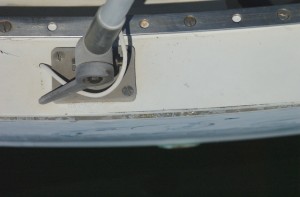Sailors work with rope–although we do not call it by that name. Sailors actually work with lines. The terms that we use for different types of it indicate where it is used on a boat. I am going to give a quick overview on some terminology.
Definitions
Lines: The term for the collective assembly of rope on a boat. You can take a piece of rope, and the second you take it from shore and bring it onto a boat, it becomes a line.
Sail Related Terminology
Halyard: Is the line that runs a sail to the top of the mast–it attaches to the head of a sail. On some older boats, this line may be comprised of wire cable spliced into rope.
Topping Lift: Is a line that runs to the top of the mast (or a partial ways to the top) for the purposes of lifting things. A topping lift is used to raise a spinnaker pole, and is sometimes attached to the boom.
Sheet: Is a line that connects the clew of a sail to the boat.
Outhaul: Is really a control used to pull tighten the foot of a sail. In most cases, it is a line attached to the clew of the sail that pulls the foot away from the mast.
Reefing Lines: Are lines that make it easy to reef the main. If you expect the conditions to be windy, you might rig your reefing lines prior to setting sail from the comfort of the harbor. Reefing is no small task (especially on large main sails), and having the reefing lines run ahead of time only make it easier.
Anchor and Docking Lines
Rode: Is a line that is attached to an anchor. This may or may not have chain in the collective rode.
Dock Lines: Are the lines used to secure the boat to the dock.
Spring Line: Is a special dock line used to cinch the boat close to the dock (or the other line). Sometimes more than one spring line is used.
Painter: Is a line that stays attached to the bow of a ship. It is a longer line and is used for all sorts of things.
Miscellaneous Terms
Life Lines: Are the lines attached to stantions on the deck of a boat. Their primary purpose is to keep things (especially people) from falling overboard.
Preventer: Is a lashing that is fixed to the boom of a sailboat to prevent it from moving to one side or the other. This is especially helpful when running downwind and trying to prevent an accidental jybe.
Thats a good place to start. I will post more terminology as it comes along.



